|
|
|
Sort Order |
|
|
|
Items / Page
|
|
|
|
|
|
|
| Srl | Item |
| 1 |
ID:
161809


|
|
|
|
|
| Summary/Abstract |
In China energy-saving mandates issued by the central government can trigger a trade-off between faithful implementation and kinds of strategic responses at the local level. This paper examines the biased data revision pattern of Chinese provinces under incentives created by energy-saving mandates. The data revisions conducted by provinces in the treatment group are evaluated against those carried out by their counterparts in the control group. Empirical evidence is provided that some provinces in the treatment group conducted biased data revisions by taking advantage of benchmark revisions of historical data following the 2008 Economic Census. These provinces adjusted their base-year energy consumption figure upward in seeking to reach the 2010 energy intensity reduction targets numerically. In institutional terms, strong political incentives are formed by assigning energy-saving indicators a veto power in cadre performance assessment. In a self-reported statistical regime, checks and balances are particularly weak regarding benchmark revisions of historical data. The findings of this paper suggest that the data quality of associated official statistics at the local level is undermined by energy-saving mandates. To improve the data quality of the official statistics, new checks and balances should be installed for local statistics.
|
|
|
|
|
|
|
|
|
|
|
|
|
|
|
|
| 2 |
ID:
161816


|
|
|
| 3 |
ID:
161812


|
|
|
|
|
| Summary/Abstract |
The extent and persistence of the inequality of regional output is an important policy issue in China and its sources have been the subject of considerable empirical research. Yet we have relatively little empirical knowledge of the effects on the regional distribution of output of shocks to national macroeconomic variables such as GDP and investment. This is an important gap in the empirical literature since much government macroeconomic policy seeks to influence GDP using instruments such as investment expenditure. It is likely that such national shocks will have differential regional impacts and so affect the regional output distribution. Policy-makers need to know the sign, size and timing of such effects before making policy decisions at the national level. We simulate the effects of aggregate shocks on individual provinces' GDP within the framework of a vector autoregressive (VAR) model restricted in a manner following Lastrapes (Economics Letters, 2005). We use annual data from 1980 to 2012 to estimate the model which includes 28 of China's provinces and simulate the effects on provincial outputs of shocks to aggregate output and investment. We find great diversity of effects across the provinces with discernible geographic patterns. There is evidence that output shocks benefit coastal provinces with developed industrial structure, export-exposure and less reliance on SOEs; the opposite is found for the effects of an investment shock and we conjecture that this is likely to have been the result of the strong bias in central government investment policy in favour of the interior provinces during a substantial part of our sample period.
|
|
|
|
|
|
|
|
|
|
|
|
|
|
|
|
| 4 |
ID:
161817
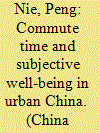

|
|
|
|
|
| Summary/Abstract |
Using data from the 2010 China Family Panel Studies, this study investigates the association between commute time and subjective well-being in a sample of 16- to 65-year-old employees in urban China. We find evidence that a longer commute time is associated with lower levels of both life satisfaction and happiness, especially when the commute times are extreme (≥ 1 hour per day). A multiple mediation analysis further indicates that the relation between commute time and happiness is partially mediated by the time spent on daily activities, particularly sleep. We also calculate the amount of income necessary to compensate an employee's loss in well-being at approximately 82 yuan per hour of commute time, implying that in urban China the annual loss of well-being amounts to around 10 billion yuan.
|
|
|
|
|
|
|
|
|
|
|
|
|
|
|
|
| 5 |
ID:
161811
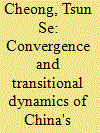

|
|
|
|
|
| Summary/Abstract |
Many scholars have argued that the huge increase in regional inequality in China can be attributed greatly to the disparity in industrialization. This paper contributes to the literature by providing empirical evidence on the transitional dynamics of industrial output by employing a new framework of distribution dynamics analysis, namely, the mobility probability plot (MPP), and a county-level database made up of counties and county-level cities. The new framework can address several inadequacies of the traditional display tools used in the distribution dynamics literature. Stochastic kernel analyses are performed for the nation, the economic zones, and the provinces individually so as to provide an in-depth understanding of the evolution and convergence of industrial output. This study fills the gap in the literature and provides information on mobility of the county-level units, which can greatly aid the policy making process.
|
|
|
|
|
|
|
|
|
|
|
|
|
|
|
|
| 6 |
ID:
161805
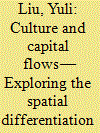

|
|
|
|
|
| Summary/Abstract |
Using a panel data of China's OFDI over the period of 2003–2013, this study investigates how cultural distance and its dimensions explain China's OFDI spatial differentiation. We find that cultural distance has a curvilinear (U-shaped) relationship with China's OFDI. The growth rates of “liability of foreignness (LOF)” and “advantages of foreignness” (AOF) finally determine whether cultural distance cause conflicts or improve innovation. In addition, we find that how China's OFDI activities are related to the difference of cultural distance hinges on the particular cultural dimension in question. The latter suggests that that the relative weight of cultural dimensions should be considered in the calculation of cultural distance. Overall, this study makes important contributions to both theory and practice. Our findings offer important insights into OFDI activities and provide guidelines for managers about entry strategies.
|
|
|
|
|
|
|
|
|
|
|
|
|
|
|
|
| 7 |
ID:
161804


|
|
|
|
|
| Summary/Abstract |
We test for the existence of a trade-off between child quantity and child quality in Chinese families. We use changes over time and space in the local stringency of the one-child policy as a source of exogenous variation in family size. Investment in child quality is measured by intake of three nutrients, using seven waves of data from the China Health and Nutrition Survey. For all three nutrients a quantity-quality trade-off is apparent, which persists for fats if child-specific effects are introduced. The trade-off would be less apparent if exogenous sources of variation in family size were ignored.
|
|
|
|
|
|
|
|
|
|
|
|
|
|
|
|
| 8 |
ID:
161819


|
|
|
|
|
| Summary/Abstract |
Chinese foreign policy is mainly characterized by the Beijing consensus and the one-China principle in international relations. More precisely, the situation faced by Taiwan is a “core interest” in China's economic diplomacy strategy. We investigate whether the “one-China policy” (OCP) has had visible effects on bilateral trade flows. In other words, does the compliance of diplomatic commitments with China undermine Taiwanese trade and enhance China's trade position? Using a structural gravity model based on worldwide panel data for the period 1948–2012, we approximate the OCP through two dummy variables: the vote by countries of the UN resolution about China's recognition in 1971 and the existence of diplomatic ties with China. The first component of the OCP drastically increased on average in trade flows with China regardless of the vote of trading partners concerning this UN resolution as well as that for Taiwan. On average, results suggest that diplomatic relations with China improve bilateral trade flows for China, but a trade-deteriorating effect appears for Taiwan with certain ex-colonies. We also find that the effects of these economic diplomacy components confirm previous results reported for the period studied.
|
|
|
|
|
|
|
|
|
|
|
|
|
|
|
|
| 9 |
ID:
161803


|
|
|
|
|
| Summary/Abstract |
This study examines how firms with heterogeneous human capital quality respond differently to a welfare policy shock. In 2002, China expanded pension mandates from state-owned enterprises (SOEs) to private enterprises. Based on data covering all median and large manufacturers in China (around 250,000 firms), we find that their compliance rates varied widely across firms and increased in the average education level of employees. Utilizing these heterogeneous responses at the firm level, we estimate that the pension reform might have increased the return to education of employees by 8.75%. To address endogeneity in firms' human capital levels, we exploit the historical scale of local university as an instrumental variable. Moreover, we use SOEs as a control group, which was not directly affected by the policy shock. We find our empirical estimates robust to both measures.
|
|
|
|
|
|
|
|
|
|
|
|
|
|
|
|
| 10 |
ID:
161815
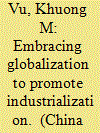

|
|
|
|
|
| Summary/Abstract |
Debates about industrial policy reveal disagreements on three salient issues. The first is whether government can overcome its own failures, namely knowledge constraints and rent-seeking, to correct market failures. The second is whether government should go beyond horizontal policies to adopt more activist interventions such as “winner-picking.” The third is whether intervention should follow or defy the country's comparative advantage. Singapore's experience in developing a globally competitive petrochemicals industry, within only a few decades and through vigorous interventions, provides meaningful insights into these debates and offers valuable lessons for developing countries. The lessons drawn from this paper suggest three fundamental principles for designing a promotion strategy and a strategic action framework for implementation.
|
|
|
|
|
|
|
|
|
|
|
|
|
|
|
|
| 11 |
ID:
161818


|
|
|
|
|
| Summary/Abstract |
In a similar way to the stock market, the housing market in China has often been portrayed as highly speculative, giving rise to “bubble” concerns. Over the last decade, residential prices increased every year on average by double digits in Beijing or Shanghai. However many observers and researchers argue that fundamentals of the housing sector, both sector-specific and macroeconomic, may have been the driving force behind housing price volatility. While existing empirical work exclusively relies on the government housing prices which may suffer from the well-documented downward bias, this paper uses original high frequency unit price as well as transaction series for the residential resale housing markets of Beijing and Shanghai between January 2005 and December 2010 to test alternative hypotheses about housing prices volatility.
|
|
|
|
|
|
|
|
|
|
|
|
|
|
|
|
| 12 |
ID:
161807
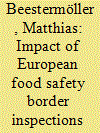

|
|
|
|
|
| Summary/Abstract |
The cost of complying with a sanitary standard is certain. However, such measure introduces uncertainty for exporters in relation to border rejections. Shipments may fail to pass inspections and may be refused entry into the importing country. This risk is shaped by variance in the quality of the exported product, and the stringency of the border controls. We examine how the risk of rejection at European borders on safety grounds is affecting Chinese agri-food exporters. We combine information from the European Rapid Alert System for Food and Feed with Chinese firm-level export data by product, destination and year for the period 2000–2011. Information externalities and reputation effects are important. Border rejections amplify the turnover among firms at the extensive margin of trade. This risk is curbing small exporters and resulting in a concentration of Chinese exports among big exporters.
|
|
|
|
|
|
|
|
|
|
|
|
|
|
|
|
| 13 |
ID:
161814
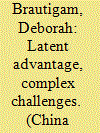

|
|
|
|
|
| Summary/Abstract |
Industrial policy is back on the African policy agenda, with a number of countries following new strategies for rapid industrialization. None have done so more eagerly than Ethiopia. The present paper draws on Justin Yifu Lin's framework of New Structural Economics to assess Ethiopia's industrial policies and engagement in the leather industry. Making use of two rounds of semi-structured interviews (2012 and 2015) with all of the foreign firms and more than a dozen local firms in the leather sector, as well as other key stakeholders, it examines seven steps the government took to build the industrial policy: Create a high-level focus on the sector; make strategic use of international development partners; attract a “lead goose” (Chinese) in the footwear sector; build government capacity to support the sector; strengthen business associations; “shock-to-shape” upgrading; improve input supply. Ultimately, while government interventions have led to improvements across several steps of the value chain, the paper identifies a number of factors that have prevented the country from fully realizing a latent comparative advantage in the leather sector.
|
|
|
|
|
|
|
|
|
|
|
|
|
|
|
|
| 14 |
ID:
161813
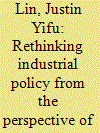

|
|
|
| 15 |
ID:
161810


|
|
|
|
|
| Summary/Abstract |
This study investigates the impact of rising wage and the appreciation of the yuan on the structure of China's exports. China's exports are classified here as ordinary exports (OE), and two distinctive groups of processing exports, pure assembly exports (PAE) and mixed assembly exports (MAE). The data analyzed here are derived from panel data covering China's bilateral PAE and MAE with 120 trading partners from 1993 to 2013. The estimates of fixed effect models show that wage increase and the appreciation of the yuan reduced the proportion of assembly exports in China's bilateral exports. Specifically, for a 10% increase in Chinese manufacturing wages, the share of PAE in China's bilateral exports is expected to fall 4.59% and that of MAE to decrease 0.9%; and a 10% nominal appreciation of the yuan against the US dollar is expected to lower the shares of PAE and MAE 8.56% and 7.26% respectively. The empirical results imply that rising wage and cumulative appreciation of the yuan have eroded China's comparative advantage in the assembly of products for international markets, resulting in substantial contraction of assembly exports. The analysis provides a supply-side explanation for the fall of China's export growth.
|
|
|
|
|
|
|
|
|
|
|
|
|
|
|
|
| 16 |
ID:
161808
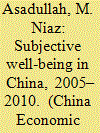

|
|
|
|
|
| Summary/Abstract |
We use data from two rounds of the Chinese General Social Survey (CGSS) to study the determinants of subjective well-being in China over the period 2005–2010 during which self-reported happiness scores show an increase across all income groups. Ordered probit regression analysis of well-being reveals large influence of gender, rural residency, and household income. After controlling for demographic attributes, health status, unemployment status, number of children, agricultural hukou (household registration identity) and educational attainment, household assets, the influence of past and future income, and province dummies, we find that women, urban residents, and people with higher income are happier in China. More schooling, better health, and being employed are positively and significantly correlated with well-being. Sub-sample analysis reveals that the rich only care about relative income whereas the effect of absolute income dominates in case of the poorer section. The influence of absolute income is larger among women compared to men and in turn explains why women, despite being poorer, are happier in China, conditional on socioeconomic differences. On the other hand, rural residents are poorer than urban residents so that conditional on having the same income, there is no rural–urban happiness gap. Our results suggest that while further decline in poverty will enhance well-being in China, policies that reduce rural–urban and gender inequalities are also likely to boost well-being.
|
|
|
|
|
|
|
|
|
|
|
|
|
|
|
|
| 17 |
ID:
161820


|
|
|
|
|
| Summary/Abstract |
Official data are criticized for over-reported agricultural labour statistics. We derive an alternative series of labour participated in agriculture with the information of production cost and revenue. Using parametric stochastic frontier approach, labour requirement functions are estimated for 30 farm and animal husbandry products in rural China. The estimated required amount of labour is compared with our newly-derived observed agricultural labour to obtain the surplus labour. This surplus ranges from 18% to 12% of agricultural labour between 2001 and 2013. Our results reveal that China was relatively successful in reducing redundant labour in rice production. Equally important, the trends of our estimated surplus place China in the second stage of transition under the Lewis-Fei-Ranis framework, moving in the direction of full commercialization or the so-called Lewis turning point.
|
|
|
|
|
|
|
|
|
|
|
|
|
|
|
|
| 18 |
ID:
161806


|
|
|
|
|
| Summary/Abstract |
This paper investigates the impact of the US and China's foreign aids to Africa on trade flows between donor and recipient countries. Evidence from the gravity model estimates reveals that the two donors' exports are strengthened by their aids to African partners. Interestingly, China's aid shows a positive effect on its total volume of trade and imports from Africa, while the aid from the US exhibits little impact on the US-Africa total trade and its imports from Africa. A possible explanation for such a difference could be due to the dissimilar national interests of donors in Africa. This study finally suggests that African countries should accelerate the pace of advancing domestic economies and rely less on foreign assistance, in order to establish a fairer and more equal international economic order.
|
|
|
|
|
|
|
|
|
|
|
|
|
|
|
|
| 19 |
ID:
161821


|
|
|
|
|
| Summary/Abstract |
Chinese investment in the African continent is rapidly spreading. Unlike the Maoist proselytism that defined past diplomatic relations between China and a few African countries, the current distribution of current Chinese Foreign Direct Investment has economic motivations. However, our study also found that Chinese investors are attracted to the political and institutional particularities of each African country. Using Stochastic Frontier Models, it has been concluded that dynamic national markets with a large population and significant forest area are the most preferred for the allocation of Chinese Foreign Direct Investment in 48 African countries between 2003 and 2010. According to our results, the efficiency of this allocation can be maximized by increased political stability and regulatory quality, with government effectiveness being an additional factor required for this efficiency.
|
|
|
|
|
|
|
|
|
|
|
|
|
|
|
|
|
|
|
|
|